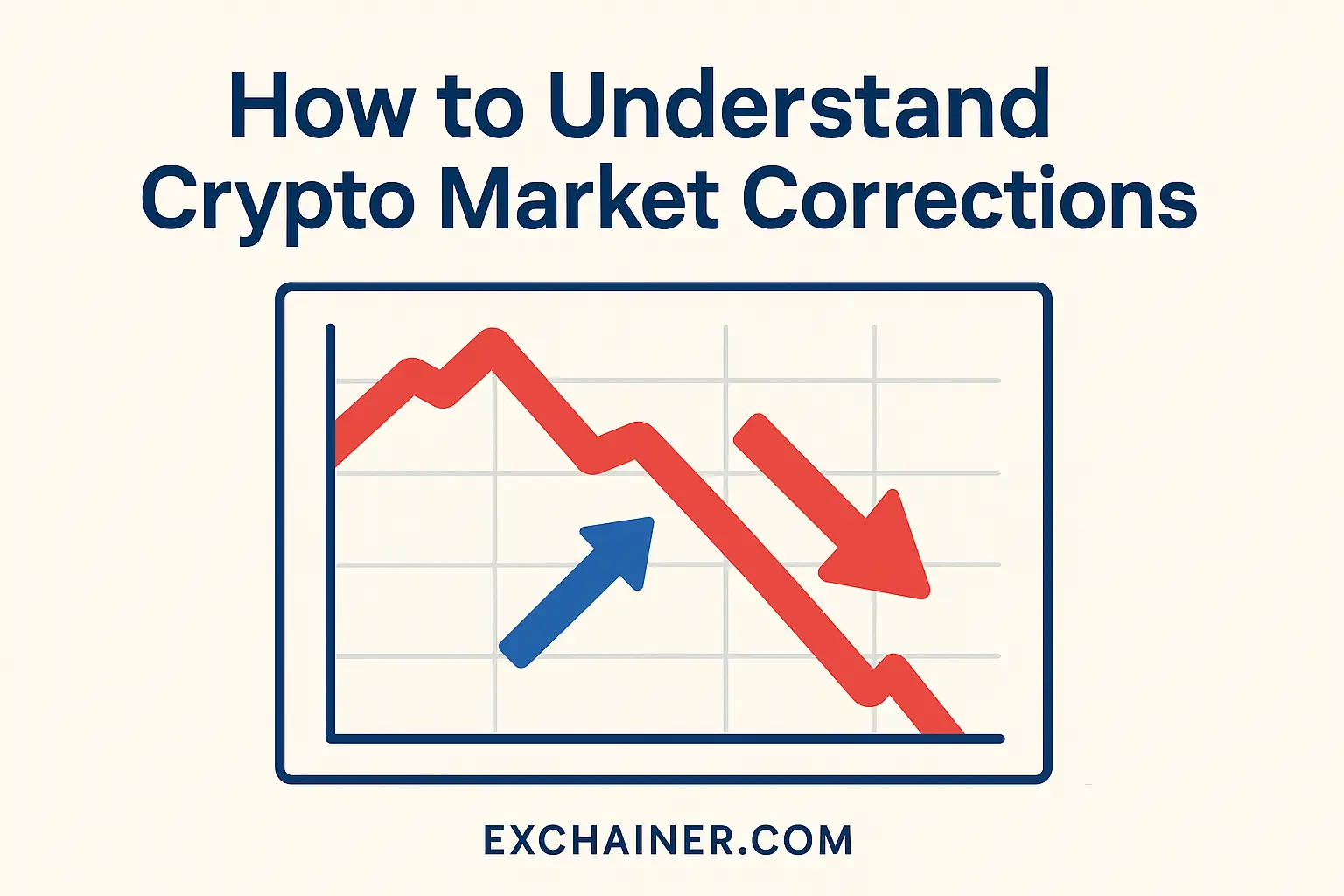Friends, if you’ve been following the rollercoaster ride of cryptocurrency prices lately, you’ve probably witnessed those sharp dips that seem to come out of nowhere. Remember the recent crypto market correction in early 2024, when Bitcoin quickly dropped over 20% in just days, rattling traders and holders alike? That event was a vivid reminder that the crypto world is not just about moonshots but also about understanding the cycles—including those inevitable pullbacks. Grasping the concept of crypto market corrections is essential if you want to protect your investments and navigate the market wisely.
In simplest terms, market corrections are periods when asset prices temporarily decline after a long rally. But what exactly triggers these corrections in crypto? How can you spot the signs early? And most importantly, how do you manage your trades and risks when the price dips hit? Whether you’re a trader looking to time entries and exits, a HODLer holding through thick and thin, or a curious beginner trying to make sense of market swings, this article on how to understand crypto market corrections will be your comprehensive guide.
We’ll explore what causes crypto market corrections, dive into crypto correction indicators you shouldn’t ignore, lay down strategies on how to trade a crypto correction, and highlight crucial tactics for risk management during crypto corrections. Packed with practical tips, chart insights, and trusted metrics, this guide will equip you to handle the wild swings of the crypto market with confidence. Plus, we’ll point you to credible resources and tools to deepen your learning.
Ready to move beyond the panic and hype? Let’s break down the mysterious world of market corrections together so you can make smarter moves next time prices start to shake.
Causes of Corrections
Understanding what causes crypto market corrections is like knowing why the floor might suddenly drop beneath your feet. The crypto environment is unique, but many correction drivers also relate to traditional finance. Let’s look at the main contributors in clear terms.
Macro & External Triggers
One powerful catalyst for corrections comes from the broader economy. When central banks raise interest rates or hint at tighter financial policies, risk assets—including cryptocurrencies—often get sold off. For example, in 2024, several Fed announcements about rate hikes correlated with pronounced downturns in Bitcoin price.
Crypto also doesn’t exist in a vacuum. Global market sentiment matters. If stocks experience a sell-off, crypto typically follows, proving its increasing correlation with equity markets. Additionally, regulatory news—like a proposed ban or tougher rules—can quickly scare investors into selling. Remember the backlash after certain countries banned crypto ads? That pushed markets into a mini-correction.
Market Structure & Liquidity Issues
Inside the crypto market, factors like leverage and liquidity play massive roles. Many traders use borrowed capital (leverage) to amplify gains — but it backfires during sudden price drops, triggering cascading liquidations. These liquidations pump more sell orders into the market, deepening the correction.
Exchanges themselves can affect liquidity, especially smaller ones with thin order books. Imagine trying to sell a big chunk of Bitcoin but not finding enough buyers without causing the price to fall sharply. That low liquidity intensifies price swings in corrections, making some falls steeper than expected.
On-chain & Project-Specific Events
Besides macro and structural factors, internal crypto events can spark corrections. Token unlocks—where large holdings become available on the market—can flood supply and pressure prices.
Security breaches like hacks can instantly erase confidence, as seen when major DeFi protocols experienced exploits, causing swift pullbacks.
Similarly, protocol upgrades or “hard forks” sometimes lead to sell-offs as uncertainty mounts among holders. Whale movements—big investors moving or selling tokens—also ripple through prices, since their trades are closely watched.
Signs & Indicators of an Impending Correction
Wouldn’t it be great to spot a crypto correction before it hits? While no one has a crystal ball, certain crypto correction indicators provide valuable early warnings. Recognizing these signals can help you brace for turbulence and possibly profit from it.
Technical Indicators to Watch
Technical analysis tools are trader favorites for spotting momentum shifts. For example, the Relative Strength Index (RSI) measures if an asset is overbought—values over 70 often indicate a market might be due for a pullback.
The MACD (Moving Average Convergence Divergence) can show momentum weakening when it crosses below its signal line, hinting at a potential correction.
Keep an eye on moving averages too—if the price breaks below important levels like the 50-day or 200-day moving averages, it often signals a trend change. Sudden volume spikes during price drops confirm selling pressure intensifying.
On-chain Metrics and Exchange Flows
Crypto’s transparency yields unique indicators. For instance, funding rates on futures markets turning negative indicate bearish sentiment as short sellers pay longs. Large exchange inflows — when significant amounts of coins move to exchanges — usually signal upcoming sell pressure, as holders prepare to liquidate.
Stablecoin supply expanding might suggest market participants are converting crypto into stable assets, anticipating drops. Whale transactions, especially large sales, act as red flags that a correction could materialize soon.
Sentiment & Derivatives Signals
Market mood gauges like the Fear & Greed Index summarize overall sentiment—from extreme greed (potential bubble) to fear (possible bottom). Social media buzz and search volumes for crypto keywords spike ahead of corrections due to panic selling or news hysteria.
In the options market, a skew toward puts (downside bets) or a spike in open interest shows rising hedging activity. High open interest nearing expiration dates can bring volatility and corrective moves.
How to Trade a Crypto Correction
Knowing how to trade a crypto correction can turn fear into opportunity—whether you want to protect profits or capitalize on dips. Here are practical tactics suited for different timeframes and risk appetites.
Short-term Strategies
Skilled traders may short cryptocurrencies during corrections by selling futures contracts or using inverse ETFs. This approach requires discipline with margin to avoid liquidations.
Volatility plays, like trading squeeze setups or scalping small rebounds, work well during choppy corrections. Fast execution and tight stop losses are vital here.
Medium/Long-term Approaches
For those focused on long-term wealth, Dollar-Cost Averaging (DCA) is a beloved strategy: buying a fixed dollar amount of crypto at regular intervals during corrections to lower average cost.
Many HODLers “buy the dip” by setting clear rules—like entering only after confirmation of a bounce or a technical support level. Rebalancing portfolios during corrections can lock in gains and adjust risk exposure effectively.
Entry, Exit, and Timing Rules
Timing is everything. Waiting for confirmation signals—such as candlestick patterns, volume increases, or technical crossovers—helps avoid premature entries.
Use limit orders to get better prices instead of market orders, which can execute at unfavorable levels in fast moves. Setting profit targets and stop losses beforehand ensures you stay disciplined and protect capital.
Risk Management During Corrections
Risk management during crypto corrections is your best defense. Corrections test your nerves and your strategy—here’s how to keep calm and secure your assets.
Position Sizing & Stop-Loss Discipline
Never risk more than a small percentage of your portfolio on any trade. Position sizing based on your total capital and stop-losses helps you survive multiple corrections without devastating losses.
Trailing stops can lock profits as the market moves favorably, adjusting automatically to price changes. Define loss limits upfront and stick to them religiously.
Portfolio-level Defenses
Diversification remains a powerful hedge—spread your investment across chains, sectors, and asset classes to reduce single-asset risk.
Use stablecoins as a safe harbor during corrections or hedge with inverse products or options to protect downside. Maintaining cash reserves lets you capitalize on buying opportunities without scrambling.
Emotional & Operational Preparedness
Market corrections can trigger panic or FOMO—don’t fall for it! Make sure you have access to your exchange accounts and wallets, understand tax or legal implications, and prepare for quick decision-making.
Keeping an emotional checklist—like breathing deeply and reviewing your plan—can prevent rushed, regretful decisions.
Conclusion
Friends, understanding crypto market corrections is crucial for anyone serious about navigating the unpredictable waters of digital currency. We’ve covered the roots of these corrections—from macroeconomic shifts and market mechanics to on-chain events that stir the pot. You’ve seen how to recognize important signals like RSI fluctuations, whale movements, and market sentiment gauges that tip you off ahead of a drop.
Trading corrections isn’t just about tapping into short-term opportunities. It’s also about managing your risk wisely—knowing when to scale back, hedge, or hold tight. Remember, corrections are not disasters but natural market rhythms that offer chances to adjust, learn, and grow.
Here’s a quick checklist to help you respond confidently next time:
1. Monitor technical and on-chain indicators regularly to spot early warning signs.
2. Adjust your position sizes and set clear stop-loss limits before entering trades.
3. Keep some cash or stablecoins ready to buy dips without rush.
4. Avoid emotional decisions—stick to your trading plan and risk rules.
5. Use multiple indicators together for confirmation rather than relying on one signal.
For deeper dives and tools, check out Crypto 101 guides or discover trusted wallets on our Tools and Wallets page. If you want to explore options for trading platforms, our Exchange Reviews category has insights to help choose the right environment.
Smart investing involves continuous learning and adaptation. So, why not share your experiences or questions below? Sign up for our alerts, and consider downloading a printable correction checklist to keep handy. Together, we’ll turn market corrections from fear factors into stepping stones for success.
Remember, as Warren Buffett famously said: “Be fearful when others are greedy and greedy when others are fearful.” Time to master that mindset in crypto!












